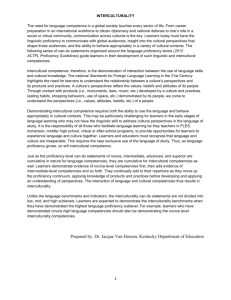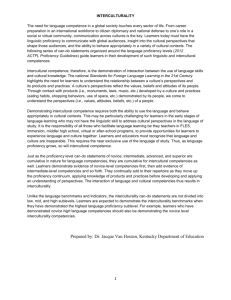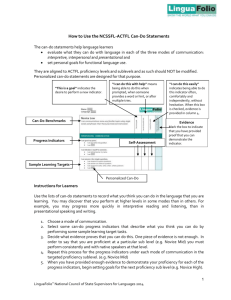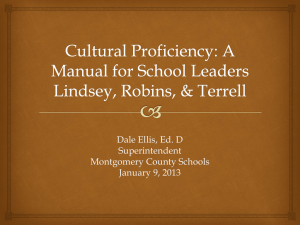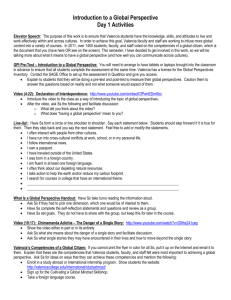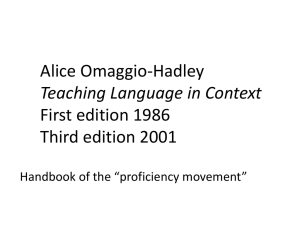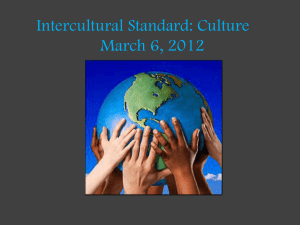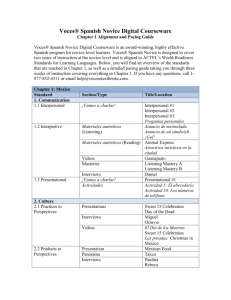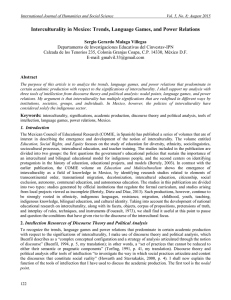I Can...(Culture) - Solon City Schools
advertisement
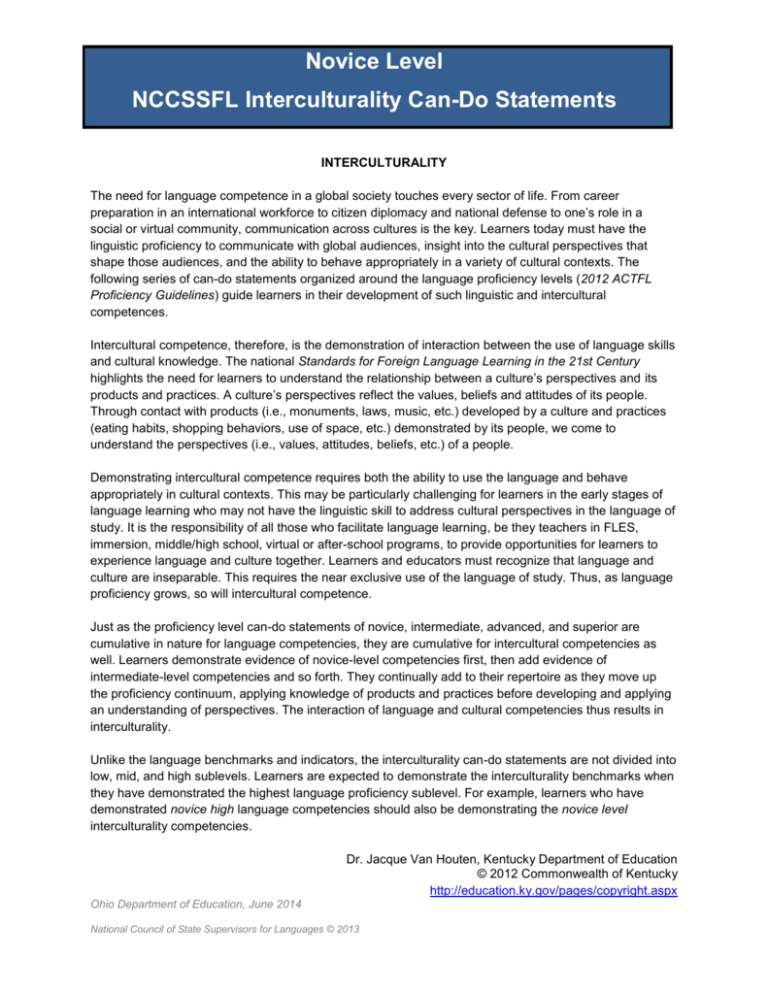
Novice Level NCCSSFL Interculturality Can-Do Statements INTERCULTURALITY The need for language competence in a global society touches every sector of life. From career preparation in an international workforce to citizen diplomacy and national defense to one’s role in a social or virtual community, communication across cultures is the key. Learners today must have the linguistic proficiency to communicate with global audiences, insight into the cultural perspectives that shape those audiences, and the ability to behave appropriately in a variety of cultural contexts. The following series of can-do statements organized around the language proficiency levels (2012 ACTFL Proficiency Guidelines) guide learners in their development of such linguistic and intercultural competences. Intercultural competence, therefore, is the demonstration of interaction between the use of language skills and cultural knowledge. The national Standards for Foreign Language Learning in the 21st Century highlights the need for learners to understand the relationship between a culture’s perspectives and its products and practices. A culture’s perspectives reflect the values, beliefs and attitudes of its people. Through contact with products (i.e., monuments, laws, music, etc.) developed by a culture and practices (eating habits, shopping behaviors, use of space, etc.) demonstrated by its people, we come to understand the perspectives (i.e., values, attitudes, beliefs, etc.) of a people. Demonstrating intercultural competence requires both the ability to use the language and behave appropriately in cultural contexts. This may be particularly challenging for learners in the early stages of language learning who may not have the linguistic skill to address cultural perspectives in the language of study. It is the responsibility of all those who facilitate language learning, be they teachers in FLES, immersion, middle/high school, virtual or after-school programs, to provide opportunities for learners to experience language and culture together. Learners and educators must recognize that language and culture are inseparable. This requires the near exclusive use of the language of study. Thus, as language proficiency grows, so will intercultural competence. Just as the proficiency level can-do statements of novice, intermediate, advanced, and superior are cumulative in nature for language competencies, they are cumulative for intercultural competencies as well. Learners demonstrate evidence of novice-level competencies first, then add evidence of intermediate-level competencies and so forth. They continually add to their repertoire as they move up the proficiency continuum, applying knowledge of products and practices before developing and applying an understanding of perspectives. The interaction of language and cultural competencies thus results in interculturality. Unlike the language benchmarks and indicators, the interculturality can-do statements are not divided into low, mid, and high sublevels. Learners are expected to demonstrate the interculturality benchmarks when they have demonstrated the highest language proficiency sublevel. For example, learners who have demonstrated novice high language competencies should also be demonstrating the novice level interculturality competencies. Dr. Jacque Van Houten, Kentucky Department of Education © 2012 Commonwealth of Kentucky http://education.ky.gov/pages/copyright.aspx Ohio Department of Education, June 2014 National Council of State Supervisors for Languages © 2013 Investigation of Products and Practices I can do this easily. I can do this with help. 1) I can identify some common products related to home and community life of other cultures and my own. This is my goal. I can identify some products and practices of cultures. Examples: I can recognize some similarities and differences between my daily schedule and that of a peer in another culture. 2) I can identify some common practices related to home and community life of other cultures and my own. I can do this easily. I can do this easily. I can identify specific locations to have a meal, purchase a ticket, or buy something that I need. I can do this with help. I can do this with help. I can identify familiar landmarks. This is my goal. Examples: I can identify some common habits of eating in other cultures. I can identify some habits of dress in other cultures. I can express the time and date as locals do. I can sometimes use the appropriate holiday greeting. Understanding of Cultural Perspectives 3) I can identify some beliefs and values related to age, gender, social class and ethnicity. This is my goal. I can identify some basic cultural beliefs and values. Examples: I can sometimes tell the way people address each other differently based on age and social standing. I can recognize that gender and age can determine one’s role in a family, school, and the workplace. Novice Level---Interculturality Can-Do Statements I can do this easily. I can do this with help. This is my goal. 4) I can identify some characteristics of national identity. Examples: I can identify symbols that represent a cultuire. I can identify the importance of some historical events through their celebration of national holidays and monuments. I can identify major religions of a nation. I can do this easily. I can do this with help. I can identify some elements of geography that define a culture. This is my goal. 5) I can identify ways in which cultures are globalized. Examples: I can identify some similar leisure activities across cultures. I can identify some similar forms of dress across cultures. I can identify examples of common technology use across cultures. Participation in Cultural Interaction I can do this easily. I can do this with help. 6) I can imitate some simple patterns of behavior in familiar settings across cultures. This is my goal. I can function at a survival level in an authentic cultural context. Examples: I can imitate appropriate greetings. I can recognize and imitate table manners. I can sometimes identify what is culturally appropriate to say when gift-giving in situations, such as a birthday party, New Year’s, a wedding, etc. I can recognize and imitate culturally appropriate behavior in a restaurant or other public place. Novice Level---Interculturality Can-Do Statements I can do this easily. I can do this with help. This is my goal. 7) I can use memorized language and very basic cultural knowledge to interact with others. Examples: I can sometimes ask and answer questions or make simple comments in a familiar cultural context such as a family event or a social event with peers. I can understand and mention a general cultural reference, such as a song or movie title, author or composer, in a conversation. I can do this easily. 8) I can use memorized language, and very basic knowledge of the culture to accomplish simple, routine tasks. I can do this with help. I can play a simple board or card game with friends. This is my goal. Examples: I can recognize and imitate how people count and use money in order to make a purchase. Novice Level---Interculturality Can-Do Statements
